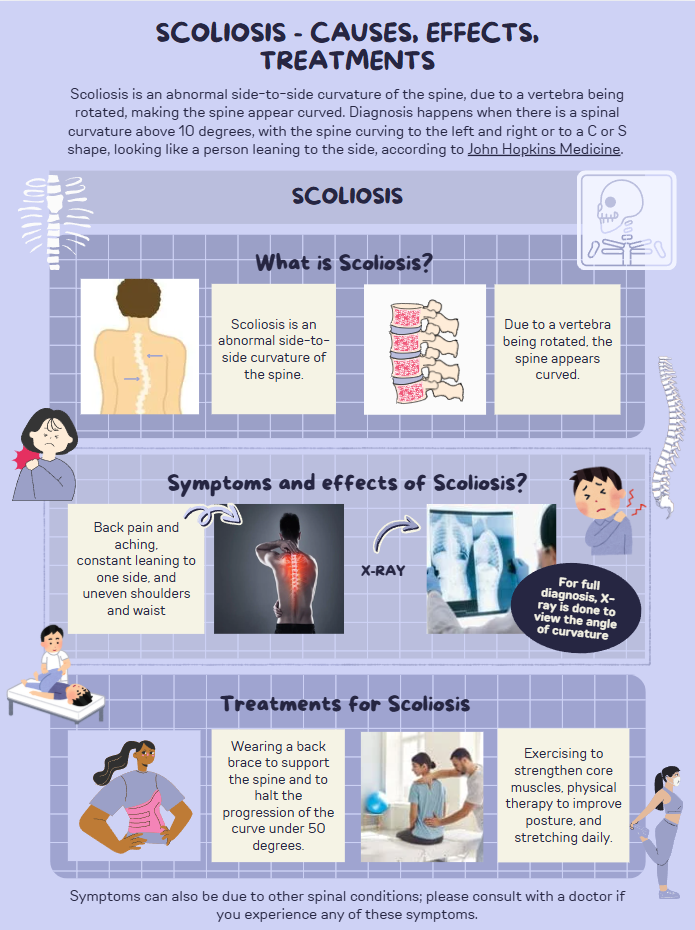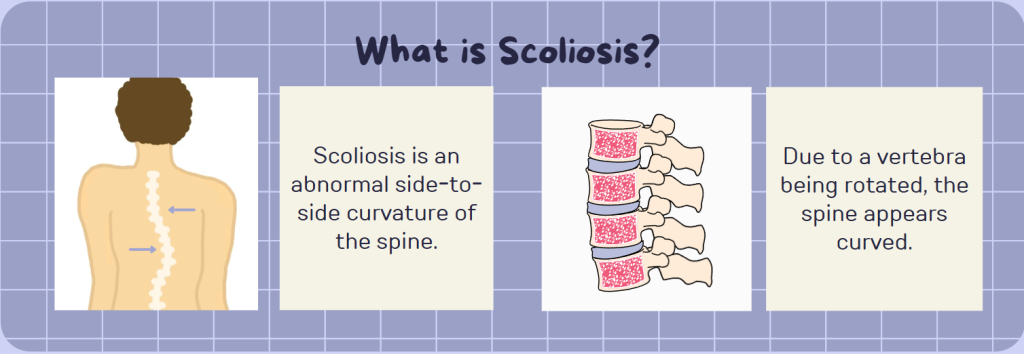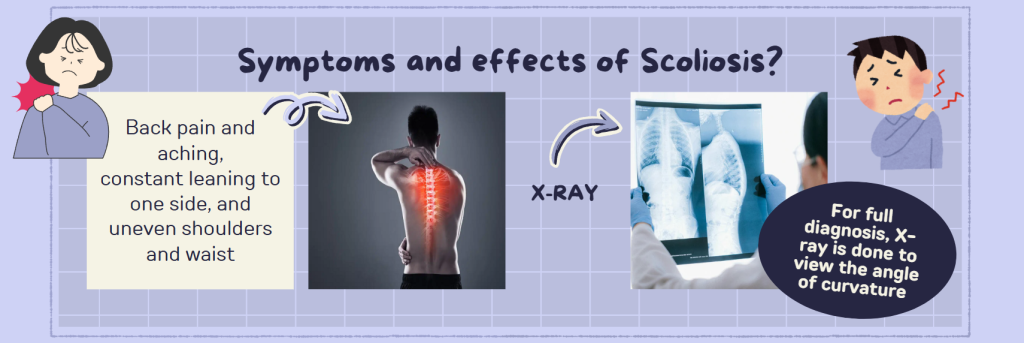
What is scoliosis?

Scoliosis is classified as an abnormal side-to-side curvature of the spine, according to the Cleveland Clinic. It happens when a vertebra is rotated, making the spine appear curved. This condition is found in roughly 2-4% of the world, with a higher prevalence among girls and women (Lee et al., 2022). Furthermore, it is often developed during childhood or adolescence and is usually diagnosed in children with the help of early screening.
Diagnosis happens when there is a spinal curvature above 10 degrees, with the spine curving to the left and right or to a C or S shape, looking like a person leaning to the side, according to John Hopkins Medicine. Diagnosis is based on the Cobb angle which is used to measure the degree of tilt and is defined as “the angle between the upper border of the uppermost vertebra in the curve and the lower border of the lowermost.” (Goldberg et al., 2007) This angle is used as a measurement tool for diagnosing the severity of a curve, helpful for developing treatment plans.
Some risk factors of developing scoliosis include genetics/family history of scoliosis, an injury affecting the spine, or weak muscles and nerves (Cleveland Clinic, 2025). Scoliosis mainly affects the thoracic and lumbar spine, as they are more prone to change with aging and growth. Therefore, early detection and intervention are important for treating scoliosis and preventing further development of the curve.
The exact cause of scoliosis is often, unknown but is generally grouped into three categories.
Types of scoliosis
There are three main types of scoliosis: idiopathic, congenital, and neuromuscular.
Idiopathic scoliosis is most commonly found and diagnosed in adolescence, as growth spurts can affect the spine curvature. The cause of idiopathic scoliosis is unknown despite extensive studies. However, there is a greater risk of developing it if a family member has it (Cleveland Clinic, 2025). Idiopathic scoliosis can also be further classified by age group.
- Infantile –younger than 3
- Juvenile –4-10
- Adolescent –11 – 18
- Adult –after 18, when skeletal growth is complete
Congenital scoliosis is rare and can be diagnosed at birth due to vertebrae not being formed during embryonic development, causing a spinal curvature to develop (Cleveland Clinic, 2025). In many cases, congenital scoliosis is diagnosed later in childhood and is usually monitored in case of further curve development.
Neuromuscular scoliosis is caused by deformities in muscles and nerves that support the spine, which could be due to injury, cerebral palsy, spina bifida, or muscular dystrophy (Cleveland Clinic, 2025). This is due to weak and unbalanced muscles, causing the spine to curve.
What are the symptoms?

- Back pain
- Hard to stand up straight
- Weak core muscle
- Leg pain, numbness, or weakness
- Uneven shoulders
- Uneven waist
- Constant leaning to one side
- Uneven leg length
- Elevated hips
- Head not centered above pelvis
- Different arm lengths
Symptoms can also be due to other spinal conditions; please consult with a doctor if you experience any of these symptoms.
Effects of scoliosis
Scoliosis can result in pain and aching, organ or nerve damage, arthritis, spinal fluid leakage, difficulties breathing, and even deformities in muscles or nerves. However, the effects of scoliosis are not limited to physical effects; it also affects one’s psychological well-being (Lee et al., 2022). This condition can have a negative impact on a person’s mental health, particularly in younger children and adolescents, due to the uncomfortable nature of brace wearing or the feeling of standing out in a crowd.
Diagnosis and testing
Screening is done by a family physician via physical exam to assess posture, alignment, and spinal curvatures. For a full diagnosis, your family physician may refer you to get an X-ray, MRI, or CT scan. Based on the degree of the angle, curves are divided into 3 types; mild, moderate, and severe.
- Null: less than 10 deg
- Mild: 10-14 deg – does not require therapeutic intervention, only monitoring
- Moderate: 25-39 deg – recommended to get bracing
- Severe: more than 40 – requires surgery
Scoliosis is measured using the Cobb angle which is used to “determine success and effectiveness of orthosis treatment” (Lee et al., 2022). A treatment is deemed successful when there is less than 5 degrees of a Cobb angle progression (Lee et al., 2022).
What treatment is offered?

Treatment is focused on relieving symptoms and slowing down curve progression. Some non-invasive treatments include exercising to strengthen core muscles, physical therapy to improve posture, stretching daily, and partaking in physical activity. In addition, regular checkups with a healthcare provider to monitor the curve progression is recommended. Your healthcare provider may suggest wearing a back brace to support your spine and to halt the progression of your curve under 50 degrees (Lee et al., 2022). There are a few different types of braces – Milwaukee, TLSO, Boston, and Charleston.
The Milwaukee brace is used to treat thoracic curves at or above T8 (Lee et al., 2022). It utilizes passive and active pressure to help in spine alignment. However, many found that wearing the brace was uncomfortable, leading to decreased compliance, as it needed to be worn for 18-23 hours a day for most effectiveness (Lee et al., 2022).
The thoracic lumbar spinal orthosis (TLSO) brace also used active and passive pressure to prevent the curve from progressing. It was reported to be more comfortable to wear, leading to increased compliance from patients (Lee et al., 2022). This brace was custom-made and fit to each patient. However, to save on cost, John Hall and William Miller developed a new, pre-made brace that could be modified to fit a patient’s needs (Lee et al., 2022).
The Boston brace is the most commonly used brace in North America and is most effective at a curve between T6 and L4, with a curvature of 20-49 degrees (Lee et al., 2022). Additionally, a study done by Katz et al. found that the Boston brace was more effective for preventing progression of the curve in individuals with a curvature between 25 and 35 degrees. However, this brace also needed to be worn for 18-23 hours per day for increased effectiveness (Lee et al., 2022).
The Charleston brace was designed to be worn during sleep (8-10 hours), and is most effective for those with a curvature between 25 and 35 degrees at an apex below T8 (Lee et al., 2022). This brace holds a patient in an overcorrected position and is custom molded (Karimi et al., 2018). However, patient compliance did not increase due to the uncomfortable brace structure and material (Lee et al., 2022).
In severe cases, with a curve 50-degrees and over, your healthcare provider may suggest surgery to treat the curve (Cleveland Clinic, 2025). Some surgeries include
- Spinal fusion –fuse bones together using metal braces to hold spine in place
- Expandable rod –insert rod along vertebrae to support growing spine of a child
However, surgery is used as a last resort and has complications like infection, bleeding, and nerve damage. Therefore, early screening and detection are vital for preventing curve progression.
Come visit our office for treatment
- If you notice symptoms
- If you are experiencing back pain
- We can help alleviate symptoms of pain and discomfort; however, for improvement of spinal curvature, please see your family physician for more information.
We offer personalized care to relieve your pain and get you moving comfortably again. Book an appointment today and feel the difference! Call us at 604-435-2285 or visit https://ruperthealth.com for more!
References
Goldberg, C. J., Moore, D. P., Fogarty, E. E., & Dowling, F. E. (2007). Scoliosis: a review. Pediatric Surgery International, 24(2), 129–144. https://doi.org/10.1007/s00383-007-2016-5
Karimi, M., & Rabczuk, T. (2018). Scoliosis conservative treatment: A review of literature. Journal of Craniovertebral Junction and Spine, 9(1), 3. https://doi.org/10.4103/jcvjs.jcvjs_39_17
Lee, G. B., Priefer, D. T., & Priefer, R. (2022). Scoliosis: causes and treatments. Adolescents, 2(2), 220–234. https://doi.org/10.3390/adolescents2020018
Scoliosis. (n.d.). John Hopkins Medicine. https://www.hopkinsmedicine.org/health/conditions-and-diseases/scoliosis
Scoliosis. (2025, June 2). Cleveland Clinic. https://my.clevelandclinic.org/health/diseases/15837-scoliosis
Leave a Reply